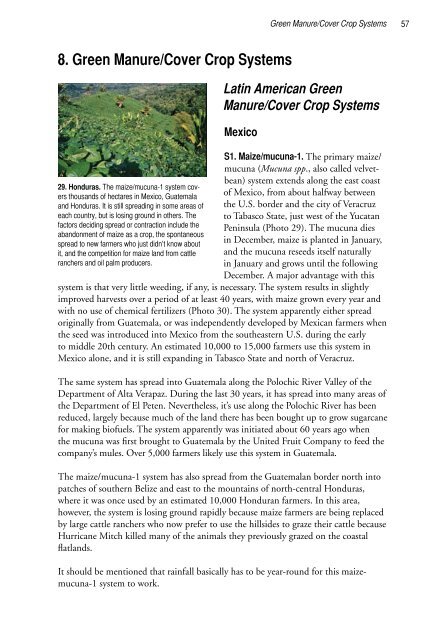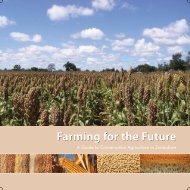Restoring the Soil - Canadian Foodgrains Bank
Restoring the Soil - Canadian Foodgrains Bank
Restoring the Soil - Canadian Foodgrains Bank
You also want an ePaper? Increase the reach of your titles
YUMPU automatically turns print PDFs into web optimized ePapers that Google loves.
Green Manure/Cover Crop Systems578. Green Manure/Cover Crop Systems29. Honduras. The maize/mucuna-1 system coversthousands of hectares in Mexico, Guatemalaand Honduras. It is still spreading in some areas ofeach country, but is losing ground in o<strong>the</strong>rs. Thefactors deciding spread or contraction include <strong>the</strong>abandonment of maize as a crop, <strong>the</strong> spontaneousspread to new farmers who just didn’t know aboutit, and <strong>the</strong> competition for maize land from cattleranchers and oil palm producers.Latin American GreenManure/Cover Crop SystemsMexicoS1. Maize/mucuna-1. The primary maize/mucuna (Mucuna spp., also called velvetbean)system extends along <strong>the</strong> east coastof Mexico, from about halfway between<strong>the</strong> U.S. border and <strong>the</strong> city of Veracruzto Tabasco State, just west of <strong>the</strong> YucatanPeninsula (Photo 29). The mucuna diesin December, maize is planted in January,and <strong>the</strong> mucuna reseeds itself naturallyin January and grows until <strong>the</strong> followingDecember. A major advantage with thissystem is that very little weeding, if any, is necessary. The system results in slightlyimproved harvests over a period of at least 40 years, with maize grown every year andwith no use of chemical fertilizers (Photo 30). The system apparently ei<strong>the</strong>r spreadoriginally from Guatemala, or was independently developed by Mexican farmers when<strong>the</strong> seed was introduced into Mexico from <strong>the</strong> sou<strong>the</strong>astern U.S. during <strong>the</strong> earlyto middle 20th century. An estimated 10,000 to 15,000 farmers use this system inMexico alone, and it is still expanding in Tabasco State and north of Veracruz.The same system has spread into Guatemala along <strong>the</strong> Polochic River Valley of <strong>the</strong>Department of Alta Verapaz. During <strong>the</strong> last 30 years, it has spread into many areas of<strong>the</strong> Department of El Peten. Never<strong>the</strong>less, it’s use along <strong>the</strong> Polochic River has beenreduced, largely because much of <strong>the</strong> land <strong>the</strong>re has been bought up to grow sugarcanefor making biofuels. The system apparently was initiated about 60 years ago when<strong>the</strong> mucuna was first brought to Guatemala by <strong>the</strong> United Fruit Company to feed <strong>the</strong>company’s mules. Over 5,000 farmers likely use this system in Guatemala.The maize/mucuna-1 system has also spread from <strong>the</strong> Guatemalan border north intopatches of sou<strong>the</strong>rn Belize and east to <strong>the</strong> mountains of north-central Honduras,where it was once used by an estimated 10,000 Honduran farmers. In this area,however, <strong>the</strong> system is losing ground rapidly because maize farmers are being replacedby large cattle ranchers who now prefer to use <strong>the</strong> hillsides to graze <strong>the</strong>ir cattle becauseHurricane Mitch killed many of <strong>the</strong> animals <strong>the</strong>y previously grazed on <strong>the</strong> coastalflatlands.It should be mentioned that rainfall basically has to be year-round for this maizemucuna-1system to work.
















